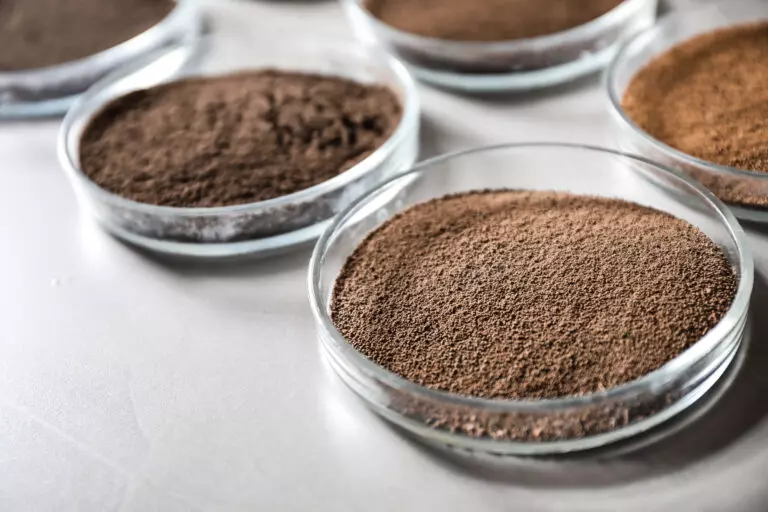
TYPES OF SOILS IN POLAND
In Poland, we can distinguish the following types of soils:
- Podzols,
- Brown soils,
- Loamy soils,
- Chernozems,
- Black earths,
- Marsh soils,
- Clays,
- Red soils,
- Mountain soils,
- Human-transformed soils.
Podzols cover 25% of the area of Poland. They can be divided into weak, moderate, and strong podzolization. The characteristic of podzolic soil is a several-centimeter layer of humus, which transitions to a leaching horizon in a light gray color. This is due to the leaching of elements and nutrients from the lower soil layer. It is also demanding – it should be well-fertilized and carefully nurtured.
Brown soils constitute about 52% of the area of Poland. They can be found near coniferous and mixed forests, which are moderately moist. They owe their name to the process of browning. It involves the weathering of various minerals in the soil, mainly aluminosilicates, which are rich in iron. As a result, these soils acquire a brown color. They are not very fertile. Their variation is loamy soils, covering 5% of the country’s area. They owe their name to the fact that the process of iron compound leaching occurs in them much faster than in other soils.
Chernozems are very fertile soils. They have a black color and a thick layer of humus, which increases their fertility. They occur in areas under meadows and steppes. They constitute 1% of the area of Poland. Black earths are very similar in composition to chernozems. They have a very high humus content, which gives them a black color. They are most commonly formed in marshy areas. They constitute 2% of the area of Poland. Marsh soils cover 9% of the area of our country. They are very fertile. Thanks to the anaerobic decomposition of organic matter, they have good properties. Mainly peat and peat-mud soils are distinguished.
Clays are most often found in river valleys. They are formed as a result of periodic flooding of rivers, which bring silt. Clays constitute 5% of the area of our country. Red soils are most common on plateaus. They have a high calcium content. They are formed on limestone rocks. These are fertile soils, but difficult to cultivate. They are built of a small humus layer, mainly formed from grass residues. Red soils are soils prone to erosion. They constitute about 1% of the country’s area. Mountain soils have very low fertility. They are mainly used for animal grazing. They are found in 6% of the area of Poland.
Of the mentioned types of soils, the first three, i.e., podzols, brown soils, and loamy soils, constitute about 80% of arable land in Poland. As previously described, these are soils with low organic matter content, and therefore very susceptible to acidification. Most of them have an acidic or very acidic reaction. Therefore, to achieve satisfactory yields of crops on them, they should be limed frequently. In the case of very low pH on these soils, powdered lime such as Kujawit or Kujawit Premium should be applied first. Unfortunately, most of these types of soils, in addition to low pH, are also characterized by low magnesium content. In this case, powdered lime containing magnesium such as Radkowit or Radkowit Premium should be used. In the case of the mentioned lime products, it is necessary to thoroughly mix them with the soil. The dose, on the other hand, depends on the pH results obtained after performing a chemical analysis of the soil sample.

In the case of soils whose reaction does not significantly differ from the optimum for the cultivation of planned plants, much more convenient to apply are granulated limes such as Polcalc III Generation or SuperMag (in the case of low magnesium content in the soil). These limes should be applied primarily 1-2 weeks after the emergence of crops. The maximum dose should not exceed 1000 kg/ha. The mentioned granulated limes should also be applied when we have received analyses of soil samples after seeding the crop and we can no longer apply powdered fertilizers. The use of Polcalc III Generation or SuperMag lime at that time will improve the soil reaction as well as increase the NPK uptake to obtain a reasonably profitable yield. The remaining previously mentioned and described types of soils, i.e., chernozems, constitute about 20%. These are more fertile soils, with a much higher organic matter content (except for mountain soils), on which satisfactory yields of crops can be obtained with lower inputs. However, it should be remembered that the use of mineral fertilizers gradually acidifies them (exceptions are red soils). Therefore, in the case of chernozems (except for mountain and red soils), one should remember to limit them, preventing their acidification by using granulated lime fertilizers such as Polcalc III Generation and SuperMag produced by Polcalc Calcium Fertilizers Ltd.
WHERE IN POLAND ARE SPECIFIC TYPES OF SOILS LOCATED?
The occurrence of a specific type of soil in a given area is related to several soil-forming factors.
Chernozems can be found in the Lublin Upland (near Chełm), in the Małopolska Upland (on the Proszowice Plateau), as well as on the Głubczyce Plateau in the Opole Voivodeship.
Black earth can be found in Kuyavia, the Greater Poland Plain, the Szczecin Lowland, the Silesian Lowland, as well as near Ciechanów and in Mazovia near Łowicz.
Marsh soils occur in Lakelands, Podlasie, and Polesie. These are fertile soils, but often too wet. Therefore, they are used as pastures and meadows.
Red soils, as soils formed on carbonate rocks, can be found in the Małopolska and Lublin Uplands.
Mountain soils, on the other hand, are found on mountain slopes, such as the Carpathians and the Sudetes. They are most often used for animal grazing. The last type of soil is those transformed by humans. They occur in the Upper Silesian Industrial District, in the areas of Warsaw, Tricity, Łódź, Kraków, Wrocław, Poznań, or Szczecin. They can also be found in areas of mines or power plants, e.g., near Bełchatów, Konin, or Turoszów.
HOW TO LIME SOILS ACCORDING TO THEIR AGRONOMIC CATEGORY?
In addition to the division of soils in terms of fertility and occurrence area, there is also a division based on the agronomic category.
Here we can distinguish soils as:
- very light (loose sand, weakly loamy, and weakly loamy dusty);
- light (loamy sand, dusty loamy, and ordinary dust);
- medium (light clay and light dusty)
- heavy (medium clay and heavy clay, loamy dust, and clay dust).
To determine which type of soil we are dealing with (according to the agronomic category), laboratory tests should be carried out. This will provide the so-called soil granulometric composition. This will allow for a precise determination of the soil structure and the selection of the appropriate fertilization and liming method.
For these soils, we have specified 5 liming needs ranges for each of them. It should be remembered that in the case of very light and light soils when their reaction is below pH 5.5, liming should already be applied using Kujawit, Kujawit Premium, Radkowit, or Radkowit Premium powdered products (with low magnesium content in the soil). However, much more convenient to use are granulated limes such as Polcalc III Generation and SuperMag, in which we can freely determine their dose per hectare and apply them primarily after the emergence of cultivated plants.
Remember farmer:
The reason for the formation of soils with low (acidic) reactions is the adverse influence of climate, more rainfall than evaporation, which leads to disturbances in the movement of nutrients in the soil. Acidification is also favored by human activity and improper fertilization.
Thanks to the knowledge of the type of soil and its agronomic category, appropriate fertilizer dosages can be selected, as well as an optimal way of limiting it. For heavy and medium soils, oxide limes, which strongly (negatively) affect microbiology, can be used for liming. However, for light soils, it is best to use lime in carbonate forms such as Kujawit and SuperMag.






